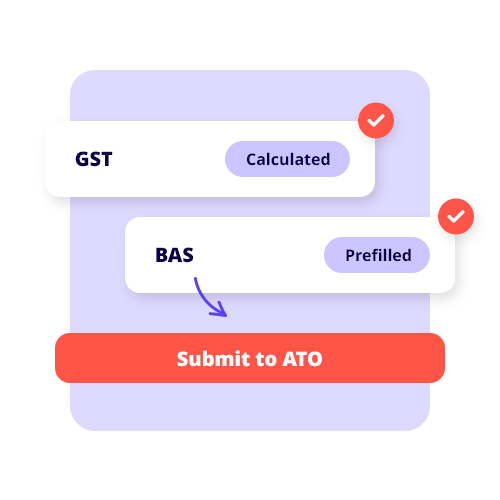Accounting software for manufacturers
Monitor your resources, maintain control over finances, and enhance your business efficiency using user-friendly online accounting software.

Why should you choose us?
Track jobs and timesheets with the best accounting software for manufacturing business
In the manufacturing business, it’s hard to find the time to sit behind a computer screen and do your payroll. With our accounting system, you can easily break down each individual job to ascertain profitability, manage expenses and keep an eye on revenue. You can also keep an eye on your payroll needs, manage timesheets and understand your employee’s workloads with accuracy.

Effortless pay runs & employee management for manufacturing companies
Our accounting software is perfect for businesses with employees to pay. From full-time to casuals and everything in between you can manage pay runs, STP, PAYG and super for just $12 per month with our easy-to-use payroll software.

Take care of compliance with automatic updates for the manufacturing industry
With automatic compliance updates for PAYG and GST, real manufacturing companies can easily keep up to date with their business needs regarding the latest legislation. Plus, you’ll always be working on the latest version to give you peace of mind and more time for doing what you love.

Professional online invoices & cash flow reporting for manufacturing companies
Keep up to date on the health of your manufacturing business, and quickly send invoices from the web or the Reckon Invoices app. Easily track the progress of your invoices with accounts receivable and accounts payable reporting.

Related resources

Small business news wrap for August!
Plans that fit your business needs and your pocket
30-DAY FREE TRIAL + SAVE 50% FOR 6 MONTHS ON ALL PLANS.
Payroll Essentials
For businesses with up to 4 employees
$6/ month
Was $12
Save $36 over 6 months
Up to 4 employees**
Process pay runs
Email payslips
Manage Single Touch Payroll
Calculate superannuation
Track leave & entitlements
Payroll reporting
Payroll companion app
Employee facing app
Track timesheets
Employee expense claims
Free data migration††
Free onboarding session
Advanced reporting
Payroll Plus
For businesses with up to 10 employees
$12.50 / month
Was $25
Save $72 over 6 months
Up to 10 employees**
Process pay runs
Email payslips
Manage Single Touch Payroll
Calculate superannuation
Track leave & entitlements
Payroll reporting
Payroll companion app
Employee facing app
Track timesheets
Employee expense claims
Free data migration††
Free onboarding session
Advanced reporting
Payroll Premium
For larger businesses
$25/ month
Was $50
Save $150 over 6 months
Unlimited employees**
Process pay runs
Email payslips
Manage Single Touch Payroll
Calculate superannuation
Track leave & entitlements
Payroll reporting
Payroll companion app
Employee facing app
Track timesheets
Employee expense claims
Free data migration††
Free onboarding session
Advanced reporting
† Transactions that exceed the 1000 limit will be subject to the BankData Fair Use Policy.
†† Free data migration offer includes 1 year of historical data + YDT only. Paid subscriptions only.
Helping thousands of businesses with their accounting
Frequently asked questions
How does the 30-day free trial work?
If life got in the way and you weren’t able to use your trial, no worries! Just give our friendly support team a shout and we’ll see if we can get you up and running again.
Can I change my software plan later on?
Definitely! Reckon One offers you the flexibility to change your plan to fit the unique needs of your business. Whether it’s downgrading or upgrading, you can easily make these changes right from your Reckon account.
How do I switch from another accounting software to Reckon One?
Head to our data migration page and see how our free* migration service works.
What do I need to get set up with Reckon One?
Is my data secure?
Do you provide customer support?
Expert training is also available through the Reckon Training Academy or our trusted partners (accountants and bookkeepers).
Can I grant access to other people?
What are the advantages of using accounting software for small businesses?
Online accounting software like Reckon One gives you the flexibility and mobility to manage your finances from any device. Gain clarity over your business’s financial position, automate your accounting process & reduce data entry, track business transactions, get paid faster, and more.
The latest version
Our small business accounting software Reckon One is automatically updated in the cloud. So you’ll always use the latest version without having to manually download compliance updates and accounting features.
Cost-effective
Reckon One pricing works on a SaaS (software as a service) pricing model. So you pay a low monthly fee instead of a large upfront payment for your software license. Paying month to month also means you aren’t locked into a contract and can cancel anytime.
Security
Your data is safely stored in the cloud so you won’t be affected by theft or accidents to physical hardware. All data servers have 24/7 security and several layers of encryption.
Is there a minimum subscription period?
Enjoy the benefits of Reckon One with the flexibility of monthly payments and if you decide it's not the right fit for your business, you can easily cancel at any time.
Try Reckon for free today
30-day free trial. Cancel at any time.






